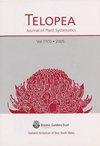格雷维利亚manglesii (Proteaceae: Grevilleoideae: Hakeinae) revisited
IF 0.5
4区 生物学
Q4 PLANT SCIENCES
引用次数: 1
摘要
manglesii(变形科)的正确引用是G. manglesii p本文章由计算机程序翻译,如有差异,请以英文原文为准。
Grevillea manglesii (Proteaceae: Grevilleoideae: Hakeinae) revisited
The correct citation for Grevillea manglesii (Proteaceae) is G. manglesii Pépin (1838). A neotype is here selected from among historic collections, now at Paris (P). Should the minimal description provided by Pépin be successfully challenged as inadequate, the name would not change but the revised authority would be Grevillea manglesii (Graham) A.Baumann and N.Baumann (1843). The origins and complex taxonomic and horticultural history of G. manglesii and its synonyms Manglesia glabrata Lindl., Anadenia manglesii Graham, Grevillea manglesii Hort., Manglesia trilobata Hort. ex Ettingsh., and Manglesia cuneata Endl. are outlined and discussed, together with new insights discerned from James Mangles’ unpublished Letter Books. The important role of Captain James Mangles R.N. to the botany and horticulture of Grevillea manglesii is reviewed and historical errors are corrected. Manglesia glabrata Lindl. is lectotypified. G. ornithopoda Meisn. is reinstated at specific rank and G. dissectifolia (McGill.) Olde is published as a new combination. Both are phenetically diagnosable without intergrades and occur in discrete populations that sometimes overlap the distribution of related species.
求助全文
通过发布文献求助,成功后即可免费获取论文全文。
去求助
来源期刊

Telopea
PLANT SCIENCES-
CiteScore
1.30
自引率
42.90%
发文量
0
期刊介绍:
Manuscripts submitted for publication in TELOPEA are published online, after peer review and acceptance by the TELOPEA Editorial Committee and when final editorial formatting has been completed. The journal specialises in plant systematics and phylogeny. The geographic scope of the journal encompasses Australia, Malesia, Melanesia, Micronesia, and Polynesia. The suitability of a work for the journal depends on the topic and the region of origin, generally the narrower the focus of the manuscript the closer to New South Wales must be its geographic focus.
As a general guide, we will consider:
1) revisionary treatments and other substantial bodies of work from any of the regions mentioned above.
2) new species from any Australian state.
3) new country records for Australia from any state.
4) new state records from New South Wales only.
However, we aim to support botanical research across the broader Australasian and Pacific region, and will consider submissions on their merit.
Generally we will not consider extraterritorial new country records, or single lectotypification papers unless they pertain to New South Wales taxa, or have significant bearing on the Australian flora.
 求助内容:
求助内容: 应助结果提醒方式:
应助结果提醒方式:


